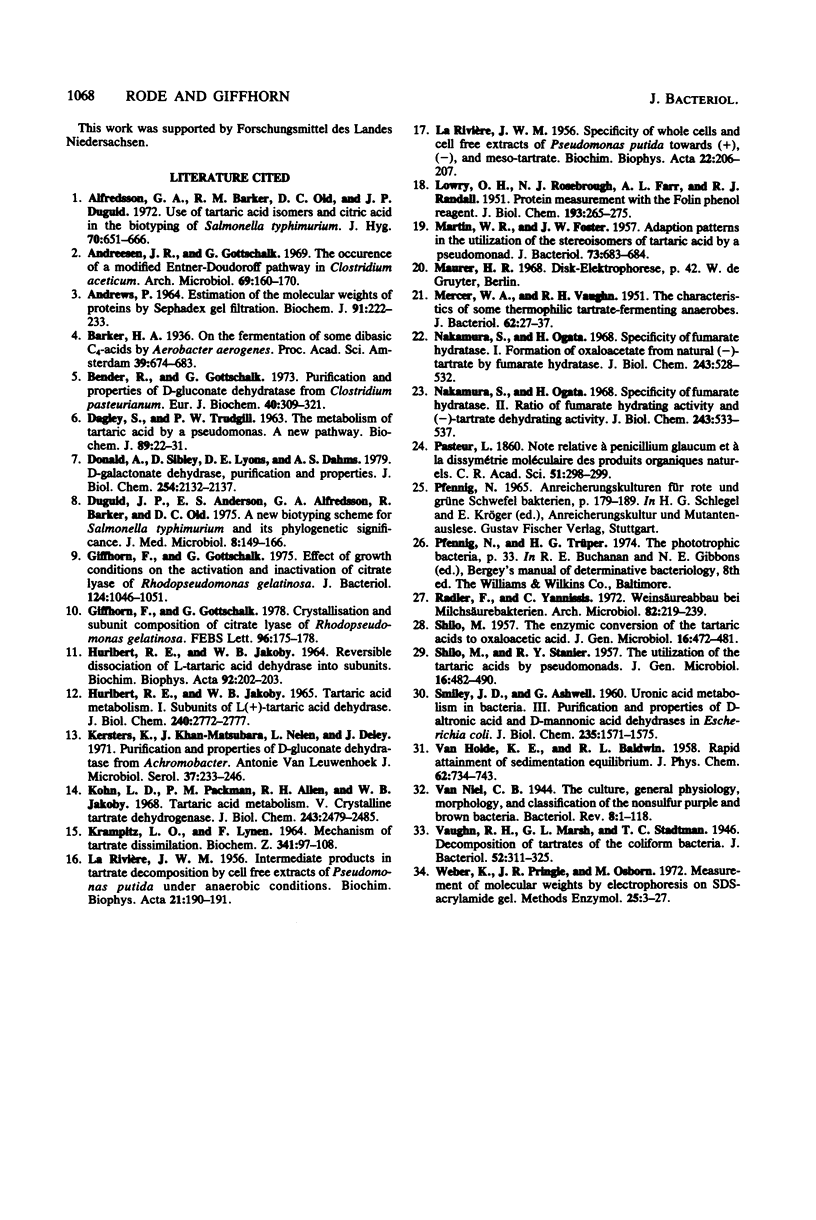Abstract
An isolate of Rhodopseudomonas sphaeroides was capable of growing phototrophically and chemotrophically (μ = 0.15 h−1 for either condition) with d-(–)-tartrate as the carbon source. A d-(–)-tartrate dehydratase, (d-(–)-tartrate hydrolyase, EC 4.1.2.70) was induced in the presence of d-(–)-tartrate. The enzyme was purified 30-fold from cell extracts of R. sphaeroides to a specific activity of 7.5 U/mg of protein and was subsequently crystallized in the presence of 1 M KCl. The enzyme was homogeneous upon analytical electrophoresis in 5% polyacrylamide gels and by criteria of ultracentrifugation. The native enzyme had a molecular weight of 158,000 ± 1,000 as determined by gel filtration and ultracentrifugation. Sodium dodecyl sulfate-polyacrylamide gel electrophoresis yielded a single polypeptide chain with an estimated molecular weight of 39,500 ± 500, indicating that d-(–)-tartrate dehydratase was a tetramer. The isoelectric point of the native enzyme was at pH 5.5. The enzyme catalyzed irreversibly the conversion of d-(–)-tartrate to oxaloacetate and water, and the turnover number was calculated to be 1,185. The reaction followed Michaelis-Menten kinetics, and a Km value of 1.8 × 10−4 M was determined. d-(–)-Tartrate dehydratase required Mg2+ for activity. The pH optimum was within a range from 6.2 to 7.2, and the activation energy of the reaction (Δ H0) was 63.2 kJ/mol. The enzyme was specific for d-(–)-tartrate; it did not react with l-(+)-tartrate, meso-tartrate, and other hydroxycarboxylic acids. d-(–)-Tartrate dehydratase was strongly inhibited by meso-tartrate (50% at 0.6 mM). l-(+)-Tartrate and a variety of hydroxycarboxylic acids caused 50% inhibition at concentrations of >30 mM.
Full text
PDF







Images in this article
Selected References
These references are in PubMed. This may not be the complete list of references from this article.
- Alfredsson G. A., Barker R. M., Old D. C., Duguid J. P. Use of tartaric acid isomers and citric acid in the biotyping of Salmonella typhimurium. J Hyg (Lond) 1972 Dec;70(4):651–666. doi: 10.1017/s0022172400022518. [DOI] [PMC free article] [PubMed] [Google Scholar]
- Andreesen J. R., Gottschalk G. The occurrence of a modified Entner-doudoroff pathway in Clostridium aceticum. Arch Mikrobiol. 1969;69(2):160–170. doi: 10.1007/BF00409760. [DOI] [PubMed] [Google Scholar]
- Andrews P. Estimation of the molecular weights of proteins by Sephadex gel-filtration. Biochem J. 1964 May;91(2):222–233. doi: 10.1042/bj0910222. [DOI] [PMC free article] [PubMed] [Google Scholar]
- Bender R., Gottschalk G. Purification and properties of D-gluconate dehydratase from Clostridium pasteurianum. Eur J Biochem. 1973 Dec 3;40(1):309–321. doi: 10.1111/j.1432-1033.1973.tb03198.x. [DOI] [PubMed] [Google Scholar]
- Donald A., Sibley D., Lyons D. E., Dahms A. S. D-Galactonate dehydrase. Purification and properties. J Biol Chem. 1979 Mar 25;254(6):2132–2137. [PubMed] [Google Scholar]
- Duguid J. P., Anderson E. S., Alfredsson G. A., Barker R., Old D. C. A new biotyping scheme for Salmonella typhimurium and its phylogenetic significance. J Med Microbiol. 1975 Feb;8(1):149–166. doi: 10.1099/00222615-8-1-149. [DOI] [PubMed] [Google Scholar]
- Giffhorn F., Gottschalk G. Crystallization and subunit composition of citrate lyase of Rhodopseudomonas gelatinosa. FEBS Lett. 1978 Dec 1;96(1):175–178. doi: 10.1016/0014-5793(78)81088-6. [DOI] [PubMed] [Google Scholar]
- Giffhorn F., Gottschalk G. Effect of growth conditions on the activation and inactivation of citrate lyase of Rhodopseudomonas gelatinosa. J Bacteriol. 1975 Dec;124(3):1046–1051. doi: 10.1128/jb.124.3.1046-1051.1975. [DOI] [PMC free article] [PubMed] [Google Scholar]
- HURLBERT R. E., JAKOBY W. B. REVERSIBLE DISSOCIATION OF L-TARTARIC ACID DEHYDRASE INTO SUBUNITS. Biochim Biophys Acta. 1964 Oct 23;92:202–204. doi: 10.1016/0926-6569(64)90298-6. [DOI] [PubMed] [Google Scholar]
- HURLBERT R. E., JAKOBY W. B. TARTARIC ACID METABOLISM. I. SUBUNITS OF L(+)-TARTARIC ACID DEHYDRASE. J Biol Chem. 1965 Jul;240:2772–2777. [PubMed] [Google Scholar]
- KRAMPITZ L. O., LYNEN F. MECHANISM OF TARTRATE DISSIMILATION. Biochem Z. 1964 Dec 7;341:97–108. [PubMed] [Google Scholar]
- Kersters K., Khan-Matsubara J., Nelen L., De Ley J. Purification and properties of D-gluconate dehydratase from Achromobacter. Antonie Van Leeuwenhoek. 1971;37(2):233–246. doi: 10.1007/BF02218486. [DOI] [PubMed] [Google Scholar]
- Kohn L. D., Packman P. M., Allen R. H., Jakoby W. B. Tartaric acid metabolism. V. Crystalline tartrate dehydrogenase. J Biol Chem. 1968 May 25;243(10):2479–2485. [PubMed] [Google Scholar]
- LA RIVIERE J. W. Intermediate products in tartrate decomposition by cell-free extracts of Pseudomonas putida under anaerobic conditions. Biochim Biophys Acta. 1956 Jul;21(1):190–191. doi: 10.1016/0006-3002(56)90122-6. [DOI] [PubMed] [Google Scholar]
- LA RIVIERE J. W. Specificity of whole cells and cell-free extracts of Pseudomonas putida towards (+), (-), and meso-tartrate. Biochim Biophys Acta. 1956 Oct;22(1):206–207. doi: 10.1016/0006-3002(56)90250-5. [DOI] [PubMed] [Google Scholar]
- LOWRY O. H., ROSEBROUGH N. J., FARR A. L., RANDALL R. J. Protein measurement with the Folin phenol reagent. J Biol Chem. 1951 Nov;193(1):265–275. [PubMed] [Google Scholar]
- MERCER W. A., VAUGHN R. H. The characteristics of some thermophilic, tartrate-fermenting anaerobes. J Bacteriol. 1951 Jul;62(1):27–37. doi: 10.1128/jb.62.1.27-37.1951. [DOI] [PMC free article] [PubMed] [Google Scholar]
- Nakamura S., Ogata H. Specificity of fumarate hydratase. I. Formation of oxalacetate from unnatural (--)-tartrate by fumarate hydratase. J Biol Chem. 1968 Feb 10;243(3):528–532. [PubMed] [Google Scholar]
- Radler F., Yannissis C. Weinsäureabbau bei Milchsäurebakterien. Arch Mikrobiol. 1972;82(3):219–239. [PubMed] [Google Scholar]
- SHILO M., STANIER R. Y. The utilization of the tartaric acids by pseudomonads. J Gen Microbiol. 1957 Apr;16(2):482–490. doi: 10.1099/00221287-16-2-482. [DOI] [PubMed] [Google Scholar]
- SHILO M. The enzymic conversion of the tartaric acids to oxaloacetic acid. J Gen Microbiol. 1957 Apr;16(2):472–481. doi: 10.1099/00221287-16-2-472. [DOI] [PubMed] [Google Scholar]
- SMILEY J. D., ASHWELL G. Uronic acid metabolism in bacteria. III. Purification and properties of D-altronic acid and D-mannonic acid dehydrases in Escherichia coli. J Biol Chem. 1960 Jun;235:1571–1575. [PubMed] [Google Scholar]
- Vaughn R. H., Marsh G. L., Stadtman T. C., Cantino B. C. Decomposition of Tartrates by the Coliform Bacteria. J Bacteriol. 1946 Sep;52(3):311–325. [PMC free article] [PubMed] [Google Scholar]
- Weber K., Pringle J. R., Osborn M. Measurement of molecular weights by electrophoresis on SDS-acrylamide gel. Methods Enzymol. 1972;26:3–27. doi: 10.1016/s0076-6879(72)26003-7. [DOI] [PubMed] [Google Scholar]
- van Niel C. B. THE CULTURE, GENERAL PHYSIOLOGY, MORPHOLOGY, AND CLASSIFICATION OF THE NON-SULFUR PURPLE AND BROWN BACTERIA. Bacteriol Rev. 1944 Mar;8(1):1–118. doi: 10.1128/br.8.1.1-118.1944. [DOI] [PMC free article] [PubMed] [Google Scholar]



